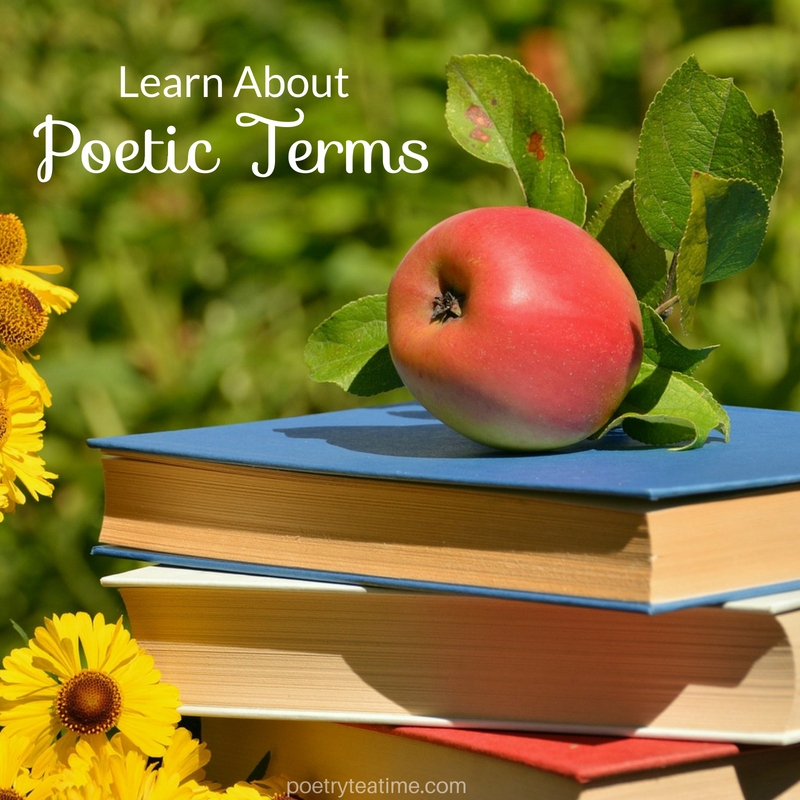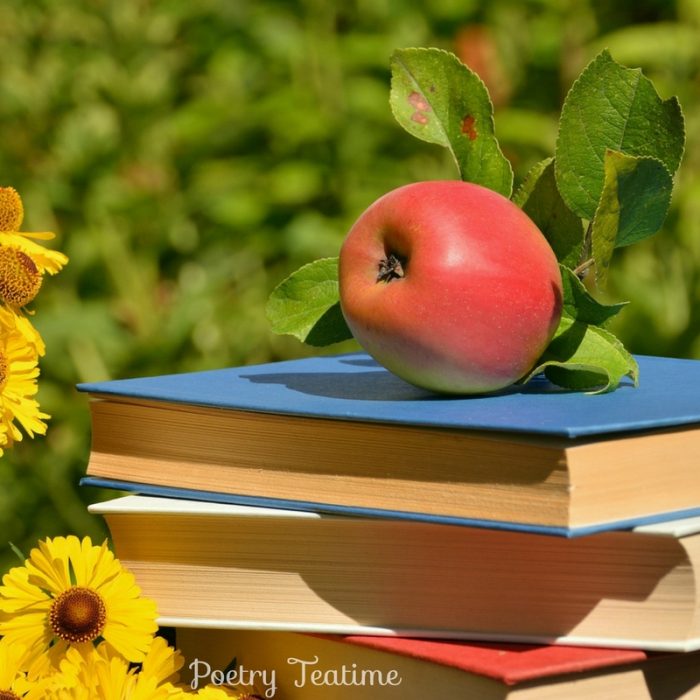Did you know that a heroic couplet isn’t actually about heroes? Or that enjambment has nothing to do with jam? If you’re going to be reading a lot of poetry, it can be helpful to know some of the most important poetic terms. Read on to discover the definitions of these key terms in poetry.
We’ve grouped this list of poetic terms into different categories. Use this list for reference if you’re feeling stuck, or pick one term to focus on during your family teatime. You can even use this list as inspiration in writing your own poetry!
Bonus: Come up with your own definition of “poetry.” How is a poem different from other kinds of writing? You may need to do some research on what famous poets and writers have said about the definition of a poem!
General Terms
- Line: The basic unit of poetry; words that don’t go all the way across the page but stop at a certain point for effect
- Stanza: Multiple lines that form a group; the “paragraph” of a poem
- Couplet: two lines
- Quatrain: four lines
- Sestet: six lines
- Octave: eight lines
- Enjambment: A line that doesn’t have end punctuation and isn’t grammatically complete, so the sentence or thought continues from one line directly to the next
- Verse: (Multiple meanings) A poem written in a specific form; a stanza of a poem
- Refrain: A line or several lines that are repeated periodically throughout a poem, especially in a ballad or hymn; often has an especially significant meaning
- Diction: The type of language in which the poem is told; can be “high” and formal, “archaic” or old and using elements of Medieval English, or “low” and conversational
Rhythm and Meter
- Rhythm: A pattern of regularly repeated sound features that often forms a beat
- Stress: The emphasis on certain syllables so that they stand out more than the syllables around them
- Feet: A unit of rhythm made of two or more syllables which are grouped together because of their pattern of stressed and unstressed syllables
- Meter: A type of rhythm that has a specific number of feet (for example, monometer has one foot, dimeter has two, tetrameter three, quitameter four, and pentameter five)
- Iambic foot: da-DA; the natural rhythm of English; think of Robert Frost’s line “Whose woods these are I think I know…”
- Anapest: da-da-DA; also called galloping meter; think of the stresses in “Twas the night before Christmas…”
- Dactyl: DA-da-da; think of words like “practical” “tactical” “brilliance”
- Spondee: DA-DA; usually used sparingly for effect; think of the first two words in the line from King Lear, “Blow, blow, thou winter wind”
- Trochee: DA-da; think of William Blake’s “Tyger, Tyger!” where the stress is on the first syllable
Rhyme and Repeated Sounds
- Rhyme: The repetition of identical or similar syllables at the ends of words, often found at the end of a line of poetry
- Rhyme scheme: A formal pattern of rhymes, usually written by using letters of the alphabet for each new ending sound (ABBA, ABCB, etc.)
- Internal rhyme: Repetition of sounds within a line of poetry
- Slant rhyme: Words with endings that don’t match exactly but sound similar
- Eye rhyme: Two words with endings that are spelled the same but pronounced differently
- Alliteration: Repetition of the same letter or sound at the beginnings of several closely connected words
- Assonance: Repetition of vowel sounds in words that are close together
- Consonance: Repetition of consonant sounds in words that are close together
Poetic Devices
- Poetic device: Tools that a poet can use to make the poem more surprising, vivid, complex, or interesting
- Metaphor: A comparison between two different things without using “like” or “as”
- Simile: A comparison between two different things that uses “like” or “as”
- Imagery: A picture that you see in your mind created by words (for example, a “pink elephant” makes you imagine a pink elephant)
- Allusion: The mention of something outside of the poem, usually a quotation or a significant mythical, literary, or historical figure or event, that the poet may not call by name or explain but expects readers to recognize
- Apostrophe: Addressing a person, idea, or object not actually present as though it was a human being that could understand and respond to the poem; often signalled by “Oh” or “O” and then a name or object
Forms of Poetry
- Sonnet: A form of poetry that uses 14 lines and has a set rhyme scheme and rhythm, usually iambic (da-DA) pentameter (five feet per line)
- Shakespearean/English sonnet: A type of sonnet made popular by Shakespeare which has a rhyme scheme of ABABCDCDEFEFGG; the couplet at the end usually contains a surprise twist or the strongest point
- Petrarchan/Italian sonnet: A type of sonnet developed by the Italian poet Petrarch, divided into an octave or eight lines and a sestet or six lines, with a rhyme scheme of ABBAABBA CDECDE; the first stanza poses a question or problem that the last stanza answers
- Ode: A poem that praises a person or thing; originally popular in Ancient Greece
- Lyric: A poem that expresses the poet’s thoughts and feelings
- Haiku: A Japanese poem with three lines in which the first and last line have five syllables and the middle line has seven
- Ballad: A poem that often originated in songs or folk traditions, which tells a story grouped in stanzas of four lines with an abcb or abab rhyme scheme and often including a refrain
- Epic: A very long poem dealing with grand heroic themes that often includes supernatural or mythic beings
- Pastoral: A poem about nature; traditionally very popular, but less common today
- Free Verse: A poem without a set rhythm or rhyme scheme
- Blank Verse: A poem written in iambic pentameter but without set end rhymes
- Heroic couplet: Two lines of rhyming iambic pentameter
- Dramatic Monologue: A poem written from the point of view of one person speaking aloud or thinking to themselves
- Ekphrastic poetry: A poem based on a work of art, sculpture, or building
- Concrete poetry: A poem where the words or lines are formed in the shape of the subject of the poem
- Verse Novel: A book-length story told using poetry
If you haven’t already, be sure to check out the links above, which will take you to a Poetry Teatime post all about that particular term. You’ll find examples of poems, books to read, and sometimes even a few creative prompts!
Hold onto this list and have a fun Poetry Teatime!



